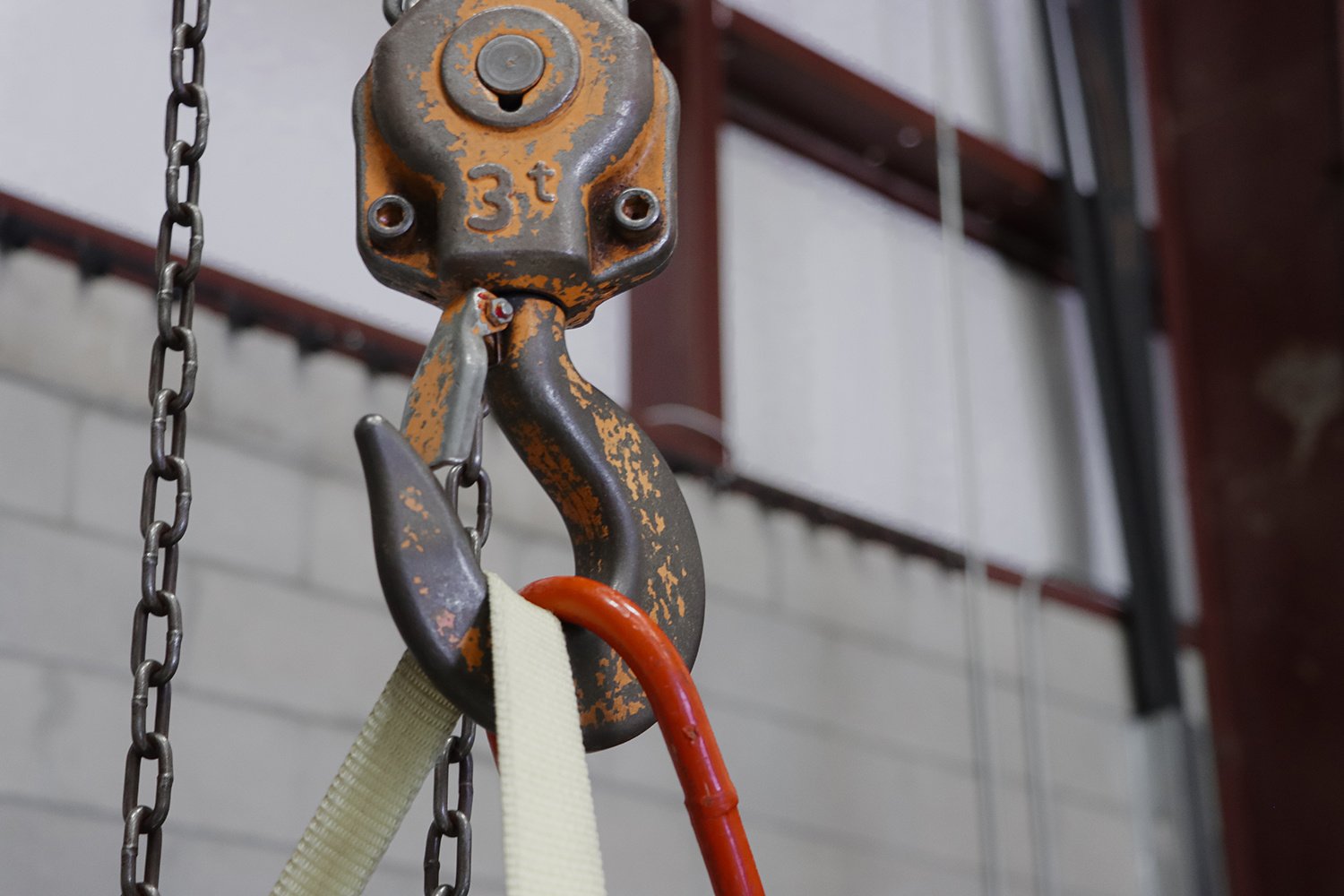
Defining a Rigger
Some might think a rigger is a person who rigs or attends to the rigging of sailing ships, aircraft, or parachutes. Nope, not what we do.
Riggers specialize in setting up and maintaining equipment used for lifting and moving objects in various industries, including construction, oil and gas, maritime, and manufacturing. Their primary responsibility is to ensure the safe and efficient handling of loads by using a combination of ropes, cables, pulleys, chains, and other rigging equipment. Yes, that is a better description of the job.
Rigging requires technical knowledge, attention to detail, and adherence to safety procedures to prevent accidents and damage to materials or equipment. The level of knowledge, training, and experience needed for this role is determined by the employer for the job that the rigger must perform. The roles and responsibilities of riggers can vary depending on the specific industry and environment in which they work. For example, ironworkers in construction would define the skill set needed to rig a load completely differently from a manufacturer building parts.
The Responsibilities of a Rigger
The ASME standards identify the responsibilities of the person performing these duties. Riggers assigned to a load handling activities shall, at a minimum, be responsible for:
- Ensuring the weight of the load and its approximate center of gravity have been combined, provided, or calculated.
- Selecting the proper rigging equipment, inspecting it, and complying with the applicable operating practices within the ASME B30 Series
- Ensuring the rated load of the rigging equipment as selected and configured is sufficient for the load to be handled, based on the number of legs, hitch configuration, and the effect of angles.
- Properly attaching rigging equipment to the hook, shackle, or other load-handling device.
- Ensuring the rigging equipment is adequately protected from abrasion, cutting, or other damage during load-handling activities.
- Rigging the load in such a manner to ensure balance and stability during the load handling activity.
- Knowing and understanding signals for the equipment in use.
- Installing and using tag lines when additional load control is required.
Anyone using or performing rigging will have these responsibilities.

The Various Types of Rigging
There are vastly diverse levels of skills and expertise needed to perform the role of a rigger, currently there is no regulatory guidance to define the different levels of expertise. for this reason, you may see many of the following terms:
- Rigging Awareness
- Rigging Fundamentals
- Rigging Trainee
- Rigger Helper
- Basic Rigger
- Rigger Level 1
- Rigger C
- Certified Rigger Level 1
- Rigger B
- Intermediate Rigger
- Qualified Rigger
- Certified Rigger Level 2
- Journeyman Rigger
- Bull Rigger
- Rigger A
- Advanced Rigger
- Master Rigger
This list is in order from the least comprehensive to the most comprehensive, with many of the terms being interchangeable.
Only one of the above terms is defined. The ASME B30.5 specifies the process for a qualified rigger, and the requirements include evidence of passing a written and practical exam.
OSHA 29 CFR 1926 specifies tasks that shall be performed by a qualified rigger, such as assembly or disassembly of a crane or working with the fall zone of a zone.
Further, OSHA simply uses the Definition of a qualified person to define qualified rigger.
There are many options available to the employer to get their employees to the correct level of expertise, then to prove it.
Some organizations have one size fits all training methods and this works out to one size fits none.
The level of training and expertise should fit the job at hand. For example, when working with mobile cranes, there should be one person associated with the lift who is qualified as a lift director, at least one person qualified as a qualified rigger, and everyone else on the crew can be qualified as a rigger trainee.
In a manufacturing facility, when a machinist utilizes a hoist for his tooling, they normally use web slings and shackles. They are performing rigging, and simply must be trained in the sling and shackle that they are using.
The Different Types of Rigger Training
When inquiring about rigger training, we start by interviewing clients about the type of work they perform, the level of expertise required to perform the job, and how they define the roles that they are looking to fill.
Rigger training comes in many distinct types and methods.
- OJT (On the Job Training)
- Rigging Awareness Training is usually attended by managers and/or supervisors overseeing rigging operations. This training is a part of the mobile crane or overhead crane safety awareness training so that managers get a deeper understanding of safely leading their lifting operations.
- Train the Trainer programs are specifically designed for a company’s in-house rigging operations and/or training personnel who will be actively involved in the development and presentation of rigging and signal person training.
- Basic Rigger training gives the participants entry-level knowledge of rigging gear, procedures, and load control using typical rigging techniques while covering signaling fundamentals.
- Qualified Rigger training includes hands-on training, classroom study and evaluation of rigging and signal person principles meeting OSHA’s rigger and signalperson qualification requirements.
- Advanced Rigger training covers turning and drifting loads, incline planes, managing the center of gravity along multiple axes and any additional advanced topics related to your organization’s rigging applications.
- CCO Rigger training prepares the candidate for the NCCCO Written and practical exams.
Rigger Training Documentation Requirements
There are currently two ways of documenting the results of the rigging testing.
- An employer qualification program is where the employer or their contractor (such as CICB) administers a written or written and practical exam and then issues documents to prove the results. Note: This qualification is only good for the employer who issues the documentation and is not transportable.
- Certification through an accredited agency (such as the NCCCO) The CCO has two Rigger certification programs, Rigger Level 1 and Rigger Level 2. The Rigger Level 1 program is a prerequisite for Rigger Level 2. CCO administers a written and practical exam for both programs. Note: This certification is owned by the employee and is fully transportable, it goes with them when they leave. Because a CCO Certification is the minimum experience for the job, an employer will still want to evaluate and document the skills of anyone that is performing the role of a rigger.
As you can see, navigating through all the definitions of “Rigger” is a challenge.
In the end we want the best trained person to do the job in the best conceivable way. To further complicate things there is no guide or book that tells us how to rig anything, they give us many practices and methods, then we must choose, based on our knowledge training and experience, based on the nature of the load, and the availability of rigging equipment, the best method to rig a load. This act of planning is what separates a Rigger from a Rigger Helper.
Elevating Your Rigging Operations With CICB
For help in navigating through this minefield of terms and definitions, contact your account manager at CICB for guidance as to the correct path to reach your destination of having safe, efficient, qualified riggers handling your loads.
About The Author
 CICB’s Texas Operations Manager John O’Connor, has held the position of senior instructor/inspector for CICB since 2006. He has a total of 28 years of experience in training, inspections, operations, planning, maintenance, administration, and personnel management for various types of lifting and earth moving equipment. He maintains a high level of proficiency in teaching crane and heavy equipment operations, inspections, and rigging using best practices, applicable OSHA, ASME and API standards and regulations. O’Connor holds NCCCO certifications for Operator, Inspector, Rigger, Signal Person, and Lift Director. He is also a NCCCO accredited Practical Examiner for Mobile and Articulating Boom Cranes, Overhead Cranes, Rigger, and Signal Person.
CICB’s Texas Operations Manager John O’Connor, has held the position of senior instructor/inspector for CICB since 2006. He has a total of 28 years of experience in training, inspections, operations, planning, maintenance, administration, and personnel management for various types of lifting and earth moving equipment. He maintains a high level of proficiency in teaching crane and heavy equipment operations, inspections, and rigging using best practices, applicable OSHA, ASME and API standards and regulations. O’Connor holds NCCCO certifications for Operator, Inspector, Rigger, Signal Person, and Lift Director. He is also a NCCCO accredited Practical Examiner for Mobile and Articulating Boom Cranes, Overhead Cranes, Rigger, and Signal Person.





